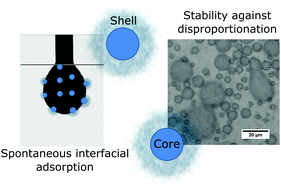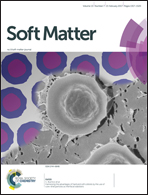Harnessing the advantages of hard and soft colloids by the use of core–shell particles as interfacial stabilizers
Abstract
The ability of colloidal particles to penetrate fluid interfaces is a crucial factor in the preparation of particle stabilized disperse systems such as foams and emulsions. For hard micron-sized particles the insertion into fluid interfaces requires substantial energy input, but soft particles are known to adsorb spontaneously. Particle hardness, however, may also affect foam and emulsion stability. The high compliance of soft particles may compromise their ability to withstand the lateral compression associated with disproportionation. Hence, particles which can spontaneously adsorb onto fluid interfaces, and yet depict low compliance may be ideal as interfacial stabilizers. In the present work, we prepared core–shell particles comprising a hard, polystyrene core and a soft poly(N-isopropylacrylamide) based shell. We found that such core–shell particles adsorb spontaneously onto various fluid interfaces. The absence of a pronounced energy barrier for interfacial adsorption allowed the facile preparation of particle-stabilized bubbles as well as emulsion droplets. For bubbles, the stability was better than that of bubbles stabilized by entirely soft particles, but disproportionation was not stopped completely. Emulsion droplets, in contrast, showed excellent stability against both coalescence and disproportionation. Lateral compression of core–shell particles due to disproportionation was clearly limited by the presence of the polystyrene core, leading to long-lasting stability. For emulsions, we even observed non-spherical droplets, indicating a negligible Laplace pressure. Our results indicate that core–shell particles comprising a hard core and a soft shell combine the advantageous properties of hard and soft particles, namely spontaneous adsorption and limited compliance, and can therefore be superior materials for the preparation of particle-stabilized dispersions.



 Please wait while we load your content...
Please wait while we load your content...